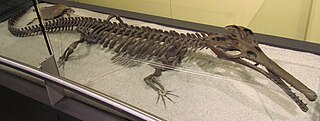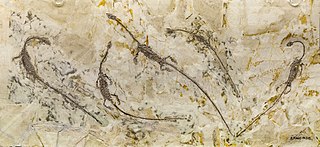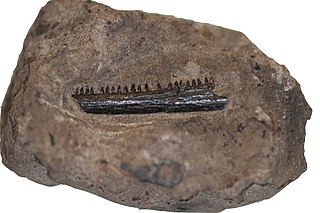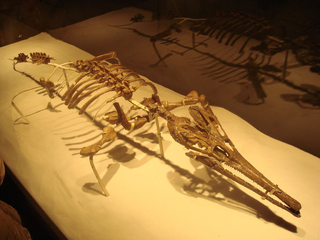
Champsosaurus is an extinct genus of crocodile-like choristodere reptile, known from the Late Cretaceous and early Paleogene periods of North America and Europe (Campanian–Paleocene). The name Champsosaurus is thought to come from champsai, (χαμψαι) said in an Ancient Greek source to be an Egyptian word for "crocodiles", and sauros, (σαύρος) Greek for "lizard". The morphology of Champsosaurus resembles that of gharials, with a long, elongated snout. It was native to freshwater environments where it likely preyed on fish, similar to living gharials.

Choristodera is an extinct order of semiaquatic diapsid reptiles that ranged from the Middle Jurassic, or possibly Triassic, to the Miocene. Choristoderes are morphologically diverse, with the best known members being the crocodile-like neochoristoderes such as Champsosaurus. Other choristoderans had lizard-like or long necked morphologies. Choristoderes appear to have been confined to the Northern Hemisphere, having been found in North America, Asia, and Europe, and possibly also North Africa. Choristoderes are generally thought to be derived neodiapsids that are close relatives or members of Sauria.

Simoedosaurus is an extinct reptile known from the Paleocene of North America, Europe and western Asia, and a member of the Choristodera, a group of aquatic reptiles that lived in the Northern Hemisphere from the Jurassic to the early Cenozoic.

Hyphalosaurus is a genus of freshwater aquatic reptiles, belonging to the extinct order Choristodera. They lived during the early Cretaceous period, about 123-120 million years ago. The genus contains two species, H. lingyuanensis from the Yixian Formation and H. baitaigouensis from both the Yixian and Jiufotang Formation of Liaoning Province, China. They are among the best-known animals from the Jehol Biota, with thousands of fossil specimens representing all growth stages in scientific and private collections.

Shokawa is an extinct genus of choristoderan diapsid reptile, known from the Lower Cretaceous of Japan. It is only known from one species, Shokawa ikoi. The only known remains are a postcranial specimen lacking the skull, discovered at the KO2 locality in sediments belonging to the Okurodani Formation near the village of Shokawa in Gifu Prefecture. Shokawa possessed a long neck with at least 16 cervical vertebrae, and closely resembles and is closely related to the smaller choristoderan, Hyphalosaurus. The generic name refers to the village near where it was found, while the specific name honors the collector of the first specimen, one Mr. Ikoi Shibata.
Pachystropheus is a genus of prehistoric reptile, from the Rhaetian of southwestern England. It was named by Erika von Huene in 1935; Huene described Pachystropheus as a choristodere, but this was overlooked for decades until its redescription by Storrs and Gower in 1993. This reevaluation would extend the fossil record of choristoderes back 45 million years. However, other authors consider attribution of Pachystropheus to Choristodera problematic, stating that it depends on vertebral and girdle characters that are also found in the skeletons of aquatic reptiles other than choristoderes; most of the diagnostic features of choristoderes are skull features, but the presence of these cannot be confirmed in Pachystropheus, as there is no confirmed skull material for this taxon. Silvio Renesto (2005) found similarities in the postcranial skeleton of Pachystropheus and the thalattosaur genus Endennasaurus; according to Renesto, these similarities may indicate that Pachystropheus and Endennasaurus are close relatives, but they might as well simply be a case of a convergent evolution triggered by the aquatic lifestyle of both taxa. The placement as a thalattosaur has been supported by other researchers.

Lazarussuchus is an extinct genus of amphibious reptile, known from the Cenozoic of Europe. It is the youngest known member of Choristodera, an extinct order of aquatic reptiles that first appeared in the Middle Jurassic. Fossils have been found in Late Paleocene, Late Oligocene, Early Miocene and possibly Late Miocene deposits in France, Germany, and the Czech Republic. Two species have been named: the type species L. inexpectatus ("unexpected") from the late Oligocene of France. and L. dvoraki from the early Miocene of the Czech Republic. It was not a large animal; with the total preserved body and tail length of L. inexpectatus being just over 30 centimetres. A complete specimen of Lazarussuchus with preserved soft tissue was found from the Late Paleocene of France, but has not been assigned to a species.

Gobiconodon is an extinct genus of carnivorous mammals belonging to the family Gobiconodontidae. Undisputed records of Gobiconodon are restricted to the Early Cretaceous of Asia and North America, but isolated teeth attributed to the genus have also been described from formations in England and Morocco dating as far back as the Middle Jurassic. Species of Gobiconodon varied considerably in size, with G. ostromi, one of the larger species, being around the size of a modern Virginia opossum. Like other gobiconodontids, it possessed several speciations towards carnivory, such as shearing molariform teeth, large canine-like incisors and powerful jaw and forelimb musculature, indicating that it probably fed on vertebrate prey. Unusually among predatory mammals and other eutriconodonts, the lower canines were vestigial, with the first lower incisor pair having become massive and canine-like. Like the larger Repenomamus there might be some evidence of scavenging.

Cteniogenys is a genus of choristodere, a morphologically diverse group of aquatic reptiles. It is part of the monotypic family Cteniogenidae. The type and only named species, C. antiquus, was named in 1928 by Charles W. Gilmore. The holotype, VP.001088, was collected in the Morrison Formation, Wyoming in 1881 by William H. Reed. More specimens have been discovered since then, including specimens from the Late Jurassic of Portugal and Middle Jurassic of Britain, which have not been assigned to species.
The Luohandong Formation is an Early Cretaceous geologic formation of the Ordos Basin in Inner Mongolia, China. The formation was initially dated to the earliest Cretaceous; Valanginian to Barremian, but later dating established an Aptian to Albian age. Dinosaur remains are among the fossils that have been recovered from the formation. Pterosaur fossils have also been recovered from the formation.

Monjurosuchus is a genus of choristoderan reptile that lived in what is now China and Japan during the Early Cretaceous. It has large eyes, a rounded skull, robust legs with short claws, and a long, thin tail. Fossils have been found that preserve soft tissue, showing that it had soft skin and webbed feet.
Irenosaurus is a genus of choristodere, a type of amphibious reptile. It is known from a single fragmentary postcranial skeleton (PIN 3386/2), discovered in the Aptian-age Lower Cretaceous Hühteeg Formation at Hüren Dukh, central Mongolia. The type species is I. egloni, which was originally described as a new species of the related choristodere Tchoiria in 1983 by Efimov. Efimov transferred the species to the new genus Irenosaurus in 1988. Evans and Hecht (1993) questioned the separation of the taxon from Tchoiria namsarai from the same locality on the grounds that the differences between the two may not have been greater than those of various species of the choristodere Champsosaurus. A later review by Efimov and Storrs (2000) retained the two as separate, noting that some characteristics of Irenosaurus are more like Khurendukhosaurus, also known from the same site, at the same time recognizing the difficulties of distinguishing three genera from the same locality. Irenosaurus was a small choristodere, approximately 1 to 1.5 metres long. It is known from what are interpreted as lake deposits.

Khurendukhosaurus is a genus of choristodere, a type of amphibious reptile. It is known from Lower Cretaceous rocks of Mongolia and Russia. Two species have been named. The type species, K. orlovi, was named in 1984 by Sigogneau–Russell and Efimov for the fragmentary postcranial skeleton PIN 3386/3. This specimen was discovered in the Albian-age Lower Cretaceous Khuren Dukh Formation Formation at Hüren Dukh, central Mongolia. The lake deposits at this site also contain fossils of the choristoderes Irenosaurus and Tchoiria. Other postcranial bones of K. orlovi have been found at this site as well.

Tchoiria () is a genus of neochoristoderan reptile from the Early Cretaceous of Mongolia. The name Tchoiria comes from the city of Choir which is nearby to where the holotype was found. Tchoiria is thought to have a similar diet to another neochoristoderan reptile, Champsosaurus, due to morphology of the skull. It would hunt in freshwater environments, like the living gharials, where it would prey on many different types of fish and turtles.

Neochoristodera is a lineage of specialised crocodile-like fully aquatic choristodere reptiles. Noted for their long jaws and large size, these animals were predominant across the Northern Hemisphere, occurring in freshwater and coastal environments across the Cretaceous and early Cenozoic.

Philydrosaurus is an extinct genus of choristoderan which existed in China during the Early Cretaceous. The type species P. proseilus was named in 2005. Philydrosaurus was found from the Jiufotang Formation and is slightly younger than Monjurosuchus, which was found from the Yixian Formation.

Chuanqilong is a monospecific genus of basal ankylosaurid dinosaur from the Liaoning Province, China that lived during the Early Cretaceous in what is now the Jiufotang Formation. The type and only species, Chuanqilong chaoyangensis, is known from a nearly complete skeleton with a skull of a juvenile individual. It was described in 2014 by Fenglu Han, Wenjie Zheng, Dongyu Hu, Xing Xu, and Paul M. Barrett. Chuanqilong shows many similarities with Liaoningosaurus and may represent a later ontogenetic stage of the taxon.
Eotomistoma is a dubious genus of crocodyliform from the Lower Cretaceous of China.
Heishanosaurus is an extinct genus of choristodere reptile from the Early Cretaceous of China. The type and currently only known species is Heishanosaurus pygmaeus. It is unusual as it is much more primitive than other known choristoderes from the Early Cretaceous of Asia, and retains many plesiomorphic characters.

Kosmodraco is a genus of large bodied choristodere from the Paleocene of North America. Originally described as a species of Simoedosaurus, it was found to represent a distinct genus in 2022. Multiple fossil skulls show a relatively short and robust snout and a skull that is considerably wider behind the eyes. Two species are currently recognized, K. dakotensis and K. magnicornis.














